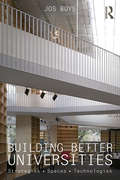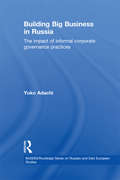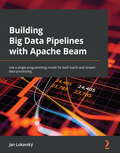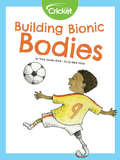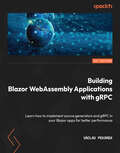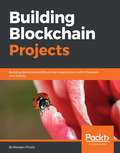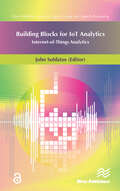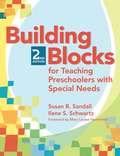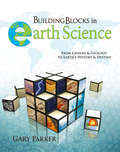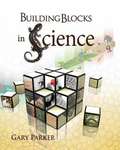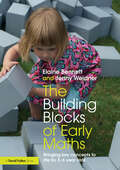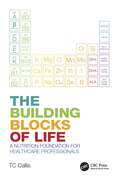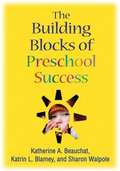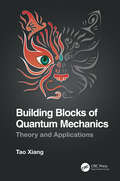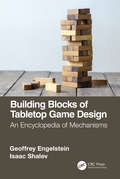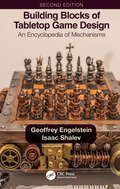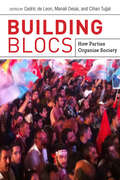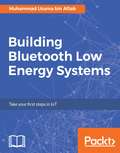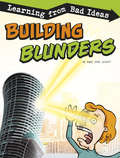- Table View
- List View
Building Better Universities: Strategies, Spaces, Technologies
by Jos BoysBuilding Better Universities provides a wide-ranging summary and critical review of the increasing number of groundbreaking initiatives undertaken by universities and colleges around the world. It suggests that we have reached a key moment for the higher education sector in which the services, location, scale, ownership, and distinctiveness of education are being altered dramatically, whether universities and colleges want it or not. These shifts are affecting traditional assumptions about both the future ‘shape’ of higher education institutions, and the roles of—and relationships between—learners, teachers, researchers, managers, businesses, communities and other stakeholders. Building Better Universities aims to bridge the gap between educational ideas about what the university is, or should be ‘for’, and its day-to-day practices and organisation. It roams across strategic, operational, and institutional issues; space planning and building design; and technological change, in order to bring together issues that are often dealt with separately. By analysing the many challenges faced by higher education in the contemporary period, and exploring the various ways universities and colleges are responding, this powerful book aims to support a ‘step-change’ in debates over the future of higher education, and to enable senior managers and faculty to develop more strategic and creative ways of enabling effective twenty-first-century learning in their own institutions.
Building Big Business in Russia: The Impact of Informal Corporate Governance Practices (BASEES/Routledge Series on Russian and East European Studies)
by Yuko AdachiThis book examines the development of big business in Russia since the onset of market oriented reform in the early 1990s. It explains how privatized post-Soviet enterprises, many of which made little sense as business units, were transformed into functional firms able to operate in the environment of a market economy. It provides detailed case studies of three key companies – Yukos Oil Company, Siberian (Russian) Aluminium and Norilsk Nickel – all of which played a key role in Russia’s economic recovery after 1998, describing how these companies were created, run and have developed. It shows how Russian businesses during the 1990s routinely relied on practices not entirely compatible with formal rules, in particular in the area of corporate governance. The book fully explores the critical role played by informal corporate governance practices - such as share dilution, transfer pricing, asset stripping, limiting shareholders access to votes, and 'bankruptcy to order’ - as Russian big business developed during the 1990s. Unlike other studies on Russian corporate governance, this book highlights the ambiguous impact of informal corporate governance practices on the companies involved as commercial entities, and suggests that although their use proved costly to Russia’s business reputation, they helped core groups of owners/managers at the time to establish coherent business firms. Overall, the book shows that we cannot understand the nature of current economic changes in Russia without recognising the crucial role played by informal corporate governance practices in the creation and development of big business in post-Soviet Russia.
Building Big Data Pipelines with Apache Beam: Use a single programming model for both batch and stream data processing
by Jan LukavskyImplement, run, operate, and test data processing pipelines using Apache BeamKey FeaturesUnderstand how to improve usability and productivity when implementing Beam pipelinesLearn how to use stateful processing to implement complex use cases using Apache BeamImplement, test, and run Apache Beam pipelines with the help of expert tips and techniquesBook DescriptionApache Beam is an open source unified programming model for implementing and executing data processing pipelines, including Extract, Transform, and Load (ETL), batch, and stream processing.This book will help you to confidently build data processing pipelines with Apache Beam. You'll start with an overview of Apache Beam and understand how to use it to implement basic pipelines. You'll also learn how to test and run the pipelines efficiently. As you progress, you'll explore how to structure your code for reusability and also use various Domain Specific Languages (DSLs). Later chapters will show you how to use schemas and query your data using (streaming) SQL. Finally, you'll understand advanced Apache Beam concepts, such as implementing your own I/O connectors.By the end of this book, you'll have gained a deep understanding of the Apache Beam model and be able to apply it to solve problems.What you will learnUnderstand the core concepts and architecture of Apache BeamImplement stateless and stateful data processing pipelinesUse state and timers for processing real-time event processingStructure your code for reusabilityUse streaming SQL to process real-time data for increasing productivity and data accessibilityRun a pipeline using a portable runner and implement data processing using the Apache Beam Python SDKImplement Apache Beam I/O connectors using the Splittable DoFn APIWho this book is forThis book is for data engineers, data scientists, and data analysts who want to learn how Apache Beam works. Intermediate-level knowledge of the Java programming language is assumed.
Building Bionic Bodies
by Tracy Vonder Brink Mark HicksDo you know someone who has a prosthetic? Many people that you might see have prosthetics and you cannot even tell! In fact, people have created and used prosthetics for thousands of years! This story shows how prosthetics have changed over time in the way they have been created and allowed mobility. You will also learn how technology has allowed prosthetics to help even more people in ways than they ever have before. Prosthetics help people to walk and run, hear, eat, and to even help them stay alive! Some may say that important pieces of technology have allowed people to become "bionic!"
Building Blazor WebAssembly Applications with gRPC: Learn how to implement source generators and gRPC in your Blazor apps for better performance
by Vaclav PekarekExplore the power of Blazor WebAssembly, gRPC, and source generators for easy and quick web developmentKey FeaturesGet to grips with integration between Blazor, gRPC, and source generators in real-life projectsDevelop a complete Blazor WebAssembly project that takes advantage of gRPC's capabilitiesExplore best practices for building a high-performance web application with Blazor and C#Book DescriptionBuilding Blazor WebAssembly Applications with gRPC will take you to the next level in your web development career. After working through all the essentials of gRPC, Blazor, and source generators, you will be far from a beginner C# developer and would qualify as a developer with intermediate knowledge of the Blazor ecosystem.After a quick primer on the basics of Blazor technology, REST, gRPC, and source generators, you'll dive straight into building Blazor WASM applications. You'll learn about everything from two-way bindings and Razor syntax to project setup. The practical emphasis continues throughout the book as you steam through creating data repositories, working with REST, and building and registering gRPC services. The chapters also cover how to manage source generators, C# and debugging best practices, and more. There is no shorter path than this book to solidify your gRPC-enabled web development knowledge.By the end of this book, your knowledge of building Blazor applications with one of the most modern and powerful frameworks around will equip you with a highly sought-after skill set that you can leverage in the best way possible.What you will learnMaster routing and test your learning with demo applicationsCreate service and controller classes for your API endpointsUse gRPC with Blazor instead of REST and revamp your applicationsStudy partial classes, attributes, and more in source generatorsWrite reusable Razor components and debug your code effectivelyUnderstand the semantic model of C# codeDiscover how to read and navigate through syntax treesBuild dynamic websites without using JavaScriptWho this book is forThis book is for beginner C# developers who want to learn how to create more performant web apps with less code using Blazor, the gRPC protocol, and source generators. The book assumes a basic understanding of C#, HTML, and web development concepts.
Building Blockbuster Products and Services: Employ an Entrepreneurial Mindset
by Ian Macmillan Rita Gunther McgrathThe current business environment is tumultuous and full of uncertainty. What you need is an entrepreneurial mindset--a way of thinking about your business that captures the benefits of uncertainty. A key aspect of establishing an entrepreneurial mindset is creating the conditions under which everyone is energized to look for opportunities to change the current business model. The simplest way to change your business model is to redesign your products and services in ways that will be supremely appealing to your customers and highly profitable for your firm. This chapter shows you how. This chapter is excerpted from "The Entrepreneurial Mindset: Strategies for Continuously Creating Opportunity in an Age of Uncertainty."
Building Blockchain Projects
by Narayan PrustyThis book is for JavaScript developers who now want to create tamper-proof data (and transaction) applications using Blockchain and Ethereum. Those who are interested in cryptocurrencies and the logic and database empowering it will find this book extremely useful.
Building Blocks: Foundations for Learning for Young Blind and Visually Impaired Children
by Betty Dominguez Joe DominguezThis bilingual (English/Spanish) book comprises six chapters each of Part I & II on Early Learning and Blind and Visually Impaired Children and on Activities for Blind and Visually Impaired Preschoolers.
Building Blocks for IoT Analytics Internet-of-Things Analytics
by John SoldatosInternet-of-Things (IoT) Analytics are an integral element of most IoT applications, as it provides the means to extract knowledge, drive actuation services and optimize decision making. IoT analytics will be a major contributor to IoT business value in the coming years, as it will enable organizations to process and fully leverage large amounts of IoT data, which are nowadays largely underutilized. The Building Blocks of IoT Analytics is devoted to the presentation the main technology building blocks that comprise advanced IoT analytics systems. It introduces IoT analytics as a special case of BigData analytics and accordingly presents leading edge technologies that can be deployed in order to successfully confront the main challenges of IoT analytics applications. Special emphasis is paid in the presentation of technologies for IoT streaming and semantic interoperability across diverse IoT streams. Furthermore, the role of cloud computing and BigData technologies in IoT analytics are presented, along with practical tools for implementing, deploying and operating non-trivial IoT applications. Along with the main building blocks of IoT analytics systems and applications, the book presents a series of practical applications, which illustrate the use of these technologies in the scope of pragmatic applications. Technical topics discussed in the book include: Cloud Computing and BigData for IoT analyticsSearching the Internet of ThingsDevelopment Tools for IoT Analytics ApplicationsIoT Analytics-as-a-ServiceSemantic Modelling and Reasoning for IoT AnalyticsIoT analytics for Smart BuildingsIoT analytics for Smart CitiesOperationalization of IoT analyticsEthical aspects of IoT analyticsThis book contains both research oriented and applied articles on IoT analytics, including several articles reflecting work undertaken in the scope of recent European Commission funded projects in the scope of the FP7 and H2020 programmes. These articles present results of these projects on IoT analytics platforms and applications. Even though several articles have been contributed by different authors, they are structured in a well thought order that facilitates the reader either to follow the evolution of the book or to focus on specific topics depending on his/her background and interest in IoT and IoT analytics technologies. The compilation of these articles in this edited volume has been largely motivated by the close collaboration of the co-authors in the scope of working groups and IoT events organized by the Internet-of-Things Research Cluster (IERC), which is currently a part of EU's Alliance for Internet of Things Innovation (AIOTI).
Building Blocks For Teaching Preschoolers With Special Needs (Second Edition)
by Susan R. Sandall Ilene S. Schwartz Gail E. Joseph Eva M. Horn Samuel L. Odom Mary Louise HemmeterUpdated for today's educators--especially those new to inclusion--the second edition of this bestselling guide is the lifeline preschool teachers need to fully include children with disabilities in their classrooms. Easy to use with any existing curriculum, including Creative Curriculum and HighScope, Building Blocks gives educators three types of practical, research-based inclusion strategies that promote progress in critical areas like behavior, emergent literacy, and peer relationships. A must for professional development, this revised edition helps teachers thrive in the era of accountability with NEW material that reflects the six years of changes in early education since the first edition. Teachers will discover how the Building Blocks approach aligns with OSEP outcomes to help teachers meet the federal requirements for special education learn everything they need to know about evidence-based practice and how to apply it in their classrooms. Through clear and instructive vignettes woven throughout the book, teachers will also meet four young children from diverse backgrounds and learn from their teachers' examples of successful interventions. A perfect training tool for teachers and an ideal textbook for college and university courses, this revised bestseller will help today's preschool educators start all their students on the road to lasting school success. Promote inclusion and improve child outcomes through curriculum modifications that allow all children to participate embedded learning opportunities used in typical classroom activities child-focused instructional strategies that help students with individual learning objectives
Building Blocks in Earth Science
by Dr Gary ParkerDevelop critical thinking skills as you explore what to believe and why you believe it! To understand earth science, it requires "teamwork," combining the methods and evidences of both science and history. And if you also use the "history book of the world," the Bible, you can make sense of the Earth's surface -- altered, formed, and weathered over time, the landscapes and vistas we enjoy today. Learn about the: Structure of the Earth and its atmosphere. Types of minerals and rocks, the water table, and types of volcanoes Earth's tornadoes, faults, polarity, magnetism, reeds, folding, hypercanes, deltas, and much more! When you understand the difference in history and science in questions related to our planet, you can more effectively discern the evidences seen in the world around you. Science is an awesome tool for understanding the workings of our world and for applying such knowledge to benefit mankind. "Scientific truth" however is not determined by consensus, compromise, majority vote, popularity, celebrity endorsement, money, media endorsement, or best-selling books -- and it is at its best when it is rooted in a worldview that begins with the Bible!
Building Blocks In Earth Science: From Genesis And Geology To Earth's History And Destiny
by Gary ParkerDevelop critical thinking skills as you explore what to believe and why you believe it! To understand earth science, it requires “teamwork,” combining the methods and evidences of both science and history. And if you also use the “history book of the world,” the Bible, you can make sense of the Earth’s surface — altered, formed, and weathered over time, the landscapes and vistas we enjoy today. Learn about the: - Structure of the Earth and its atmosphere. - Types of minerals and rocks, the water table, and types of volcanoes - Earth's tornadoes, faults, polarity, magnetism, reeds, folding, hypercanes, deltas, and much more! When you understand the difference in history and science in questions related to our planet, you can more effectively discern the evidences seen in the world around you. Science is an awesome tool for understanding the workings of our world and for applying such knowledge to benefit mankind. “Scientific truth” however is not determined by consensus, compromise, majority vote, popularity, celebrity endorsement, money, media endorsement, or best-selling books — and it is at its best when it is rooted in a worldview
Building Blocks in Science
by Dr Gary ParkerHave you ever wondered about human fossils, "cave men", skin color, "ape-men", or why missing links are still missing? Want to discover when T. Rexwas small enough to fit in your hand? Or how old dinosaur fossils are - and how we know the age of these bones? Learn how the Bible's world view (not evolution's) unites evidence from science and history into a solid creation foundation for understanding the origin, history, and destiny of life - including yours! Start reinforcing a strong foundation for learning with study questions, discussions, discussion topics, and more for home and school educators! In this fascinating book, Gary Parker explores some of the most interesting areas of science: fossils, the errors of evolution, the evidence of creation, all about early man and human origins, dinosaurs, and even "races." Learn how scientists use evidence in the present, how historians use evidence of the past, and discover the biblical world view, not evolution, that puts the two together in a credible and scientifically-sound way! Having made his own journey of discovery, this former evolutionary biologist and popular author offers a unique and powerful perspective on the science of our world - past and present. Build your world view on a faith that fits the scientific facts!
The Building Blocks of Early Maths: Bringing key concepts to life for 3-6 year olds
by Elaine Bennett Jenny WeidnerYoung children need to develop and understand the core basic concepts in mathematics before they can move forward in their mathematical learning. Without these solid foundations, they are more likely to have gaps in their knowledge and require intervention in their primary years. This new book provides guidance and resources to help you develop children’s key skills and understanding in mathematics. Written by experienced teachers, the book outlines key mathematical concepts and provides a wide range of exciting, mathematically rich activities that support the development of these concepts. It exposes some of the common misconceptions and errors that practitioners may observe children showing in their settings and offers simple practical strategies to help move children forward in their thinking and understanding. Covering all areas of mathematics learning – counting and number, calculation, shape and space, pattern, measuring and handling data – the book features: practical ideas for supporting assessment, observation, mathematical vocabulary and building links with home activities that promote a child-led approach, linked to children‘s everyday lives and experiences guidance on how to extend and challenge children’s learning through adult-led, quality teaching and effective practice a clear sense of progression based on children’s understanding rather than age. Written by experienced practitioners, The Building Blocks of Early Maths will help you to ensure that the children in your care have the strong foundations they need to become confident successful mathematician in the future.
The Building Blocks of Life: A Nutrition Foundation for Healthcare Professionals
by TC CallisWithin the United Kingdom (UK), most mainstream healthcare practitioners receive little or no nutrition education during their years of training. As a consequence, the understanding of nutrition amongst primary care practitioners such as general practitioners, pharmacists, midwives, and practice nurses is limited and is largely focused on energy consumption and obesity. There is little knowledge of the wealth of micronutrients that underpin health, nor of the ticking timebomb of insufficient intakes of those micronutrients amongst a significant proportion of the population in the UK.The Building Blocks of Life: A Nutrition Foundation for Healthcare Professionals is a step towards redressing that balance. It sets out an informative and engaging narrative on how and why nutrition is the basis for good health. It discusses UK-specific issues with regards to diet and intakes of vitamins, minerals, essential fatty acids and other micronutrients. It also raises concerns about the potential negative health implications of the generally poor UK diet and suggests ways that healthcare practitioners can support patients in improving their long-term health outlook.Nutrition policy in the UK needs to be dragged into the 21st century and this book sets out evidence-based arguments which challenge current public health myths such as the idea that 10 micrograms of vitamin D is all anyone needs or the messaging around the consumption of saturated fat vs highly processed seed oils or that everyone can get all the nutrients they need from a varied and balanced diet.Although The Building Blocks of Life: A Nutrition Foundation for Healthcare Professionals focuses on concerns around poor diet and the consequent micronutrient inadequacies in the UK, the nutritional detail is relevant no matter where you are in the world. Everyone eats, all the time. It is time that mainstream medicine looked towards food as both a cause and a solution to many of the chronic degenerative conditions that plague modern life.
Building Blocks of Preschool Success
by Katrin Blamey Katherine BeauchatWritten expressly for preschool teachers, this engaging book explains the "whats," "whys," and "how-tos" of implementing best practices for instruction in the preschool classroom. The authors show how to target key areas of language and literacy development across the entire school day, including whole-group and small-group activities, center time, transitions, and outdoor play. Detailed examples in every chapter illustrate what effective instruction and assessment look like in three distinct settings a school-based pre-kindergarten, a Head Start center with many English language learners, and a private suburban preschool. Helpful book lists, charts, and planning tools are featured, including reproducible materials.
Building Blocks of Quantum Mechanics: Theory and Applications
by Tao XiangThis textbook provides a concise yet comprehensive introduction to the principles, concepts, and methods of quantum mechanics. It covers the basic building blocks of quantum mechanics theory and applications, illuminated throughout by physical insights and examples of quantum mechanics, such as the one-dimensional eigen-problem, the harmonic oscillator, the Aharonov-Bohm effect, Landau levels, the hydrogen atom, the Landau-Zener transition and the Berry phase. This self-contained textbook is suitable for junior and senior undergraduate students, in addition to advanced students who have studied general physics (including classical mechanics, electromagnetics, and atomic physics), calculus, and linear algebra.Key features: Presents an accessible and concise treatment of quantum mechanics Contains a wealth of case studies and examples to illustrate concepts Based off the author's established course and lecture notes
The Building Blocks of ROI: How to Calculate and Understand Return on Investment
by Joe Knight Karen BermanThis chapter discusses foundational principles, including the time value of money, for making decisions relating to capital investment in corporate America. To be a successful entrepreneur, you must understand the basics of spending cash in the hope of realizing a return - like buying a new machine or software application. This chapter is excerpted from "Financial Intelligence for Entrepreneurs: What You Really Need to Know About the Numbers."
The Building Blocks of ROI
by Joe Knight Karen Berman John CaseThis chapter discusses foundational principles, including the time value of money, for making decisions relating to capital investment in corporate America.
Building Blocks of Tabletop Game Design: An Encyclopedia of Mechanisms
by Geoffrey Engelstein Isaac ShalevBuilding Blocks of Tabletop Game Design: An Encyclopedia of Mechanisms compiles hundreds of different mechanisms, organized by category. Each has a description of how it works, discussion of its pros and cons, how it can be implemented, and examples of specific games that use it. Building Blocks can be read cover to cover, used as a reference when looking for inspiration for a new design, help solving a specific problem, or assist in getting unstuck in the midst of a project. This book, the first to collect mechanisms like this in the tabletop game design field, aims to be a practical guide that will be a great starting point for beginning designers, a handy guidebook for the experienced, and an ideal classroom textbook. Key Features The first compendium of its kind in the tabletop game field. Covers the nuts and bolts of design to resolve specific challenges. Serves as a practical guide, a great starting point for beginning designers, and a reference for seasoned professionals. Contains discussion of a series of standalone mechanisms, in a standard format and style, with cross-links to related mechanics and specific examples. Includes hundreds of mechanism entries with accompanying diagrams and sample games to study. Ideal for professional or classroom use.
Building Blocks of Tabletop Game Design: An Encyclopedia of Mechanisms
by Geoffrey Engelstein Isaac Shalev"If games were lands to be explored, they would be far too large for one explorer to master. Building Blocks of Tabletop Game Design is a much-needed atlas for the explorer—giving a framework of what to look for in a game, and a focus for game play that will be useful for understanding the whole. The game scholar will find this invaluable." —Richard Garfield, creator of Magic: The Gathering "People talk about the art of game design or the craft of game design. Engelstein and Shalev hone in on the science of game design with a razor-sharp scalpel. This book will be within arm’s reach as I work on games and I expect it to be consulted often." —Rob Daviau, creator of Risk: Legacy and Chief Restoration Officer of Restoration Games "The most comprehensive and well-researched encyclopedia of game mechanisms that I’ve seen to date." —Matt Leacock, creator of Pandemic Building Blocks of Tabletop Game Design: An Encyclopedia of Mechanisms, Second Edition compiles hundreds of game mechanisms, organized by category. The book can be read cover-to-cover and used as a reference to solve a specific design problem or for inspiration and research on new designs. This second edition collects even more mechanisms, expands on and updates existing entries, and includes color images. Building Blocks is a great starting point for new designers, a handy guidebook for the experienced, and an ideal classroom reference. Each Game Mechanisms Entry Contains: The definition of the mechanism An explanatory diagram of the mechanism Discussion of how the mechanism is used in successful games Considerations for implementing the mechanism in new designs Geoffrey Engelstein is a game designer and educator. His designs include the Space Cadets series, The Dragon & Flagon, The Expanse, and Super Skill Pinball. He has published several books on game design, including GameTek: The Math and Science of Gaming, Achievement Relocked, and Game Production. He is on the faculty of the NYU Game Center as an adjunct professor for Board Game Design and has been invited to speak about game design at PAX, GenCon, Metatopia, and the Game Developers Conference. Isaac Shalev is a game designer, author, and educational games consultant. He has designed tabletop titles including Seikatsu, Waddle, and Show & Tile. He runs Sage70, Inc., a data strategy and games-based learning consultancy that serves nonprofit organizations. He lives in Cary, North Carolina with his wife, three children, and a dog.
Building Blocs: How Parties Organize Society
by Cihan Tuğal Manali Desai Cedric De LeonDo political parties merely represent divisions in society? Until now, scholars and other observers have generally agreed that they do. But Building Blocs argues the reverse: that some political parties in fact shape divisions as they struggle to remake the social order. Drawing on the contributors' expertise in Indonesia, India, the United States, Canada, Egypt, and Turkey, this volume demonstrates further that the success and failure of parties to politicize social differences has dramatic consequences for democratic change, economic development, and other large-scale transformations. This politicization of divisions, or "political articulation," is neither the product of a single charismatic leader nor the machinations of state power, but is instead a constant call and response between parties and would-be constituents. When articulation becomes inconsistent, as it has in Indonesia, partisan calls grow faint and the resulting vacuum creates the possibility for other forms of political expression. However, when political parties exercise their power of interpellation efficiently, they are able to silence certain interests such as those of secular constituents in Turkey. Building Blocs exposes political parties as the most influential agencies that structure social cleavages and invites further critical investigation of the related consequences.
Building Bluetooth Low Energy Systems
by Muhammad Usama AftabDiscover and implement a system of your choice using Bluetooth Low Energy. About This Book • Learn the basics of Bluetooth Low Energy with its exciting new protocol stack and security. • Build customized Bluetooth Low Energy projects that make your web or mobile apps smarter in terms of networking and communications. • Using Android, iOS, and the Web, acquire key skills to harness the power of Bluetooth Low Energy in your IoT applications. Who This Book Is For The book is for developers and enthusiasts who are passionate about learning Bluetooth Low Energy technologies and want to add new features and services to their new or existing products. They should be familiar with programming languages such as Swift, Java, and JavaScript. Knowledge of debugging skills would be an advantage. What You Will Learn • Bluetooth Low Energy in theory. • Bluetooth Low Energy Hardware and Software Development Kits. • Implement Bluetooth low energy communication (central and peripheral) using Android. • Master BLE Beacons with examples implemented over Eddystone and iBeacons. • Implement indoor navigation using Estimote Beacons on iOS. • Implement Internet gateways to control BLE devices on a Wi-Fi network. • Understand BLE security mechanisms with a special focus on Bluetooth pairing, bonding, and key exchange to cover encryption, privacy, and user data integrity. • Implement Bluetooth Mesh using CSRMesh Technology. In Detail Bluetooth Low Energy (BLE) is a Wireless Personal Area network technology aimed at novel applications for smart devices. High-tech BLE profiles and services are being increasingly used by application developers and hardware enthusiasts to allow devices to interact with the surrounding world. This book will focus on a technical introduction to BLE and how it is reshaping small-distance communication. We will start with IoT, where many technologies such as BLE, Zigbee, and IEEE 802.15.4 Mesh will be introduced. The book will present BLE from an engineering perspective, from which the protocol stack, architecture, and layers are discussed. You will learn to implement customized projects for Peripheral/Central communication, BLE Beacons, indoor navigation using triangulation, and the Internet gateway for Bluetooth Low Energy Personal Network, all using various code samples and APIs on Android, iOS, and the Web. Finally, the book will conclude with a glimpse into future technologies destined to be prominent in years to come. Style and approach The book is a practical tutorial that will help you understand the background and technicalities of BLE and offers a friendly environment to build and create robust BLE projects. This hands-on approach will give you a clear vision of Bluetooth Low Energy and how it can be used in IoT.
Building Blunders: Learning from Bad Ideas (Fantastic Fails)
by Amie Jane LeavittSee some of the world's biggest building blunders up close and personal. Find out how each structure failed, the basic building block that was missed during construction, and what engineers learned from their mistakes.
Building Boats that Float (Fun STEM Challenges)
by Marne VenturaWhat does it take to make a boat float? Gather some supplies and try it out for yourself! Discover tips and ideas on how to build the best boat around!
